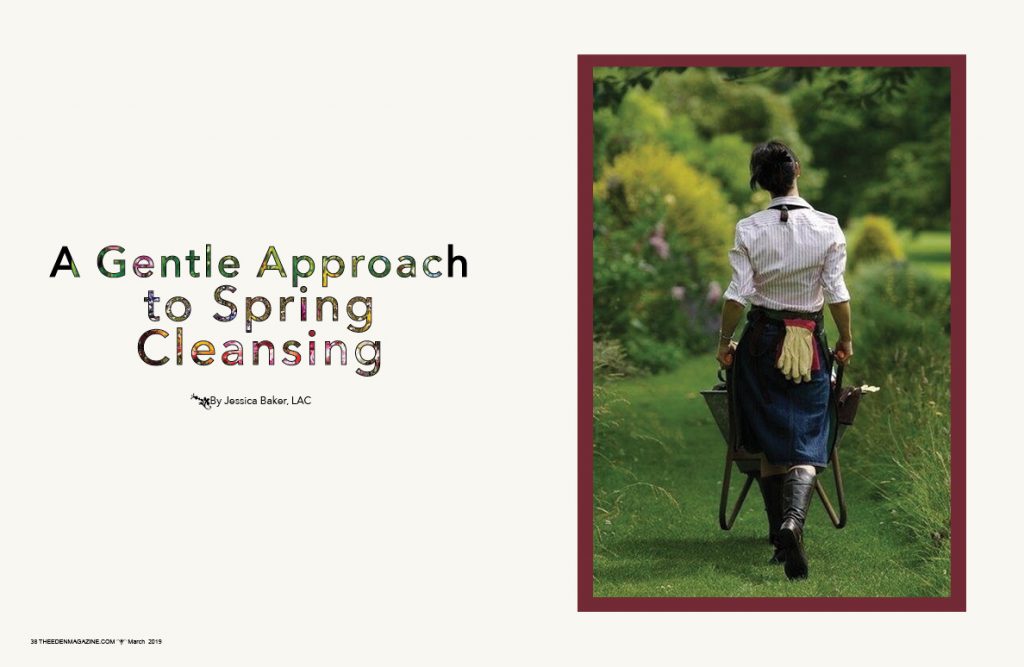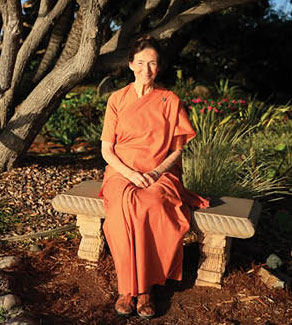By Jessica Baker, LAC
I see way too much aggressiveness when it comes to Spring cleanses. There is a popular yet misguided approach with emphasis on harsh herbs and handfuls of supplements to purge your body of built up toxicity. In my opinion, there is nothing more counterproductive to your health than putting undue strain on your kidneys (and liver) to assimilate eighteen different herbal capsules at the same time you starve yourself of vital nutrients. I know this extreme approach isn’t true for all people who cleanse, but there are too many herbal cleansing companies on the market for it not to be true. As an acupuncturist and herbalist I have seen this approach too often.
I have a gentler attitude and milder style to cleansing. Spring is still cold in many places and winter like weather can continue for another month or more, so early Spring is not the best time for cleansing. It is the time to start adding young bitter greens to your diet.
The new shoots that generate in Spring are bitter and cool and will help clear heat from the digestive system that may have accumulated from eating heavier foods in winter.
In today’s society most of us can eat however we choose regardless of the season. Up until fairly recently, unless you lived in a temperate environment, winter eating consisted of dried fruits, nuts, grains, root vegetables, and meat. Fresh leafy greens and vegetables were not available, so eating the early Spring greens as a way to generate enzymatic activity and stimulate metabolism was essential after months of eating dried, starchy, or heavy foods. Examples of Spring greens that would be beneficial to cleansing would be Plantain (Plantago lanceolata), Red Clover (Trifolium pratense) and Nettles (Urtica dioica).
The intention of a Spring cleanse should not be to force change through drastic measures. A lot of the herbal cleansing products are very cold and or slightly toxic herbs that can contribute to problems with digestion and metabolism. Someone with a compromised digestive system can take weeks or months to recover from the injury that harsh cleansing can create. This does not happen when we approach cleansing with a gentle hand, one that focuses on giving the body a chance to fully assimilate nutrients and repair cellular damage caused by our modern, fast-paced lifestyle.
I have a few basic guidelines I encourage when someone asks me for a Spring Cleanse!
1. Cleanse for the 3 days around Spring Equinox
(March 20-22).
If possible, lighten your work and personal load to the bare minimum so you have time to assimilate what comes up for you during the cleanse. Use this time as an opportunity to relax, write, paint, sing, whatever inspires you. Take small walks in Nature but nothing that will exert too much energy.
Cleansing is a great opportunity to let go of resentment; frustration, ego and anything else that may be holding you back from making space for new energy to come into your life. Be patient with yourself and the process of healing.
2. Drink herbal tea instead of taking capsules, powders, or tinctures.
Like happens often in a world of consumerism, we have taken the idea of cleansing and gone to the extreme. We think we need jars of pills, gallons of juice, and hours in the bathroom to have a successful cleanse. We champion ourselves on suffering through our cleanse when really we need to be gently nourishing our tissues and hydrating our cells with nutritive herbal teas.
Some great choices for herbal teas are nervines like Milky Oats (Avena sativa) and Chamomile (Matricaria recutita). All of these herbs are inexpensive and easy to source and grow and can gently nourish and heal the body without taxing the system in any way.
3. Eat lightly or drink diluted juices throughout the day.
Upon waking drink 6 ounces room temperature water. Add a squeeze of lemon if desired. Throughout the day, drink at least 4 glasses of water and 3 cups of herbal tea.
Eat between 2-5 small meals each day. Eat only lightly steamed vegetables, especially roots like beets, dandelion and burdock, and handfuls of steamed leafy greens like chard and kale. The roots are full of inulin, iron and other vital nutrients and will keep you grounded and less likely to get light headed from the lack of calories that accompany a cleanse. The steamed bitter greens clear heat and dampness that can accumulate with high fat, gluten or sugary diets. They also provide fiber, protein, and carbohydrates.
You are welcome to have diluted juices each day. Make sure they are primarily vegetable juices and dilute them by half with water. Add a little fresh ginger to juices to help digest the raw juice.
If you feel you need some protein during the cleanse, you may have up to ½ cup soaked nuts like brazil nuts or walnuts or seeds like hemp or sesame. Consume small amounts throughout the day instead of eating all at once.
During the cleanse, try to avoid all meat and animal products, alcohol, coffee, black tea, dairy, garlic, onion, processed foods and iced or frozen beverages. Other than fresh juices, do not consume too many raw fruit or veggies.
4. Hydrotherapy
Every evening dry brush with a loofah, starting from your chest and moving outward towards your extremities. After the dry brush, take a baking soda and salt bath and soak for at least 30 minutes. Make sure to stay well hydrated during and after your bath. Lather yourself with oil before dressing.
After the three-day cleanse, continue to eat simply and nurture yourself with good selfcare. If you feel like you need more cleansing, take 1-2 days out of every week to eat lightly, rest and rejuvenate.
RECIPES FOR SPRING CLEANSING
Detoxifying & Nourishing Herbal Tea
2 tsp Milky Oat tops (Avena sativa)
1 tsp Chamomile flowers (Matricaria recutita)
1 tsp Nettle leaves (Urtica dioica)
1 tsp Red clover flowers (Trifolium pratense)
Put all herbs in a pint jar. Steep in hot water for 15 minutes. Strain and drink throughout the day.
Baking Soda Bath
Add 1 cup of Baking Soda and 1 cup of Epsom Salts to a warm bath. Soak for 30 minutes. Drink plenty of water during and after the bath.
Jessica Baker, LAc, RH (AHG) is an author, acupuncturist, herbalist, aromatherapist and educator. Her passion for all plants is reflected in her formulations, private practice and classes on aromatherapy, herbalism, and Chinese medicine. As a continuing education provider, she teaches at several herbal symposia and conferences throughout the United States. Jessica is on the faculty of the Holistic Cannabis Academy and teaches The Colorado School of Clinical Herbalism. Having many years experience as a clinician, Jessica is a master formulator, understanding the importance of plant synergy and energetics. Jessica has completed her first book, Plant Songs: Reflections on Herbal Medicine, through Balboa Press. Her Baker Botanica 5 Element essential oil blends are now available.
Website- www.bakerbotanica.com
Email- jessica@bakersbrands.com
Facebook- www.facebook.com/bakerbotanica
Instagram- www.instagram.com/baker_botanica_
The Herb Walk Blog- www.jessicabaker.blog







